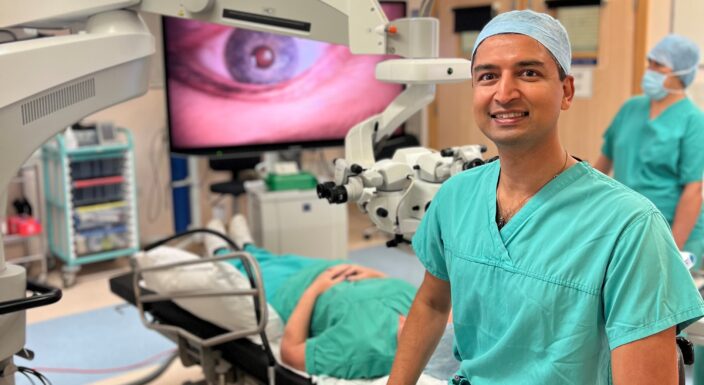
NNUH first in region for innovative corneal transplant surgery
We are the first Trust in the region to offer innovative and highly-specialised corneal transplant surgery, giving our patients quicker healing times and better visual outcomes.
Transplant surgery involves removing all or part of a damaged cornea and replacing it with healthy, clear corneal tissue from a donor.
People living with a condition called Fuchs’ Endothelial Dystrophy, or those who have a weakened cornea following cataract surgery, may require this specialist surgery.
Previously, patients in Norfolk could have a type of transplant called DSAEK (Descemet’s stripping automated endothelial keratoplasty) where a thicker layer of corneal tissue is transplanted.
The new DMEK (Descemet’s membrane endothelial keratoplasty) involves manually removing a single sheet of cells from a donated cornea and inserting it into the patient via a much smaller incision.
Older methods required general anaesthetic and sutures could take up to a year to heal. The new procedure can be carried out under local anaesthetic, patients can return home the same day and are usually left with above driving standard vision.
“With the new surgery, only a small air bubble is used to hold the corneal cells in place,” said Chrishan Gunasekera, Ophthalmologist, who is the first to perform this surgery in Norfolk.
“The air bubble remains in the eye for about two to three days after the transplant. Only transplanting a single sheet of cells gives amazing visual outcomes.”
Angela Adams, from North Norfolk, has suffered with eye problems since 2012 and was later diagnosed with Fuchs’ Endothelial Dystrophy.
“Prior to the procedure my vision was cloudy and misty, I could see halos around lights and a lot of glare,” she said. “Everything lacked clarity and at times I had significant discomfort.
“Once home, I had to lay on my back looking at the ceiling for the first 72 hours. I had 10 minutes every hour when I could change position. The day after the operation I looked out of my cottage windows and was completely overwhelmed to see the shrubs, the leaves, and the flowers. The colours and shapes had completely transformed. I could see them with absolute clarity. They were beautiful and it was in this moment I realised why my quality of life had declined leading up to this point. I was also overwhelmed with gratitude for the person who had been generous enough to donate their cornea to give someone sight. I felt very blessed.
“I have had many moments of amazement since my surgery and seeing Cromer pier and people on the beach was another overwhelming feeling. I can start looking for seals swimming in the sea again! I am profoundly grateful to the expertise of the team involved. Anyone hesitant about this surgery should know the results are incredible.”
“Of the first few patients we’ve done so far, they’ve had above the driving standard of vision by week one following the transplant,” added Chrishan.
“Previously that could take anywhere from two to three months, or up to a year, depending on the type of operation they had. So, the visual recovery is much quicker and because we’re using just a single sheet of cells, the body is much less likely to reject the tissue. Rejection rates are only 1% compared to around 10% previously.
“This is highly specialised surgery and is great for local patients because it means that if you do have a problem, we can offer a technique that allows rapid healing.”
Up to 100 of these new transplants could be carried out here every year, with patients referred from further afield.


